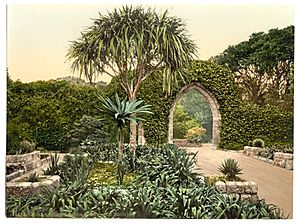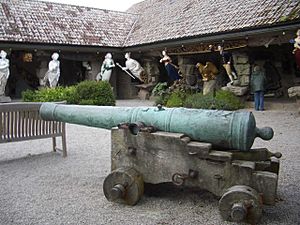Tresco Abbey Gardens facts for kids
Quick facts for kids Tresco Abbey Gardens |
|
|---|---|

Tresco Abbey Gardens, 2007
|
|
| Lua error in Module:Location_map at line 420: attempt to index field 'wikibase' (a nil value). | |
| Type | Botanical |
| Location | Tresco, Isles of Scilly, England |
| Area | 17 acres (6.9 hectares) |
| Founder | Augustus Smith |
| Owned by | Robert Dorrien-Smith |
| Operated by | Tresco Estate |

The Tresco Abbey Gardens are amazing gardens found on the island of Tresco in the Isles of Scilly, United Kingdom. These gardens cover about 17 acres (which is roughly the size of 13 football fields!). They were started by a man named Augustus Smith in the 1800s. He was in charge of the islands back then. The gardens began as his own private space around his home. Today, they are considered a very important historical garden in England.
Contents
The Abbey House
Augustus Smith picked Tresco for his home because it was pretty much in the middle of all the other islands. It was also near the old abbey ruins, close to a fresh water pond, and had a nice view of the sand dunes and beach. When he started building his house in 1835, the area was mostly empty land.
His first house was quite small compared to what it is now. He added more parts to it in 1843 and 1861. The house is made of granite stone with a slate roof. Some of the wood used for the dining room and other rooms came from a shipwreck in 1861! Later, in 1891, his successor, Thomas Smith-Dorrien-Smith, added the tall tower you can see today.
The Abbey Gardens
When Augustus Smith decided to create his house and garden, one of the first things he did was build a strong granite wall. This wall helped protect the area from the strong winds. He also planted gorse seeds, which are spiky bushes, to create more shelter.
Inside the gardens, you can still see parts of a very old Benedictine abbey that was first built in 964 AD. Most of what is left today comes from the Priory of St Nicholas, which was started by monks in 1114.
Since there were hardly any trees on the island, the gorse bushes weren't enough to block the wind. So, Augustus Smith planted special rows of trees called shelterbelts. At first, he planted trees like elm, sycamore, oak, and poplar. Later, he added fast-growing trees like Monterey cypress and Monterey pine, which are great for coastal areas.
Growing the Plant Collection
A lot more plants were added to the gardens by Arthur Dorrien-Smith in the early 1900s. He traveled many times to South Africa to find new and interesting trees and plants. He even went on a scientific trip to islands near Antarctica in 1907! After that, he explored New Zealand and Australia. By 1909, he had collected about 2,280 different plants and seeds!
Thanks to the mild winters, lots of summer sunshine, and the tall walls and hedges that protect the garden from strong Atlantic winds, Tresco Abbey Gardens is now home to amazing plants from all over the world. You can find plants from the Mediterranean, South America, South Africa, and Australasia here.
Red Squirrels in the Gardens
In 2012, five red squirrels were brought to the Abbey Gardens. Only two of them survived, so in 2013, a new group of squirrels was flown to Tresco by helicopter from the British Wildlife Centre in Surrey. This helped create a new home for these cute creatures.
Valhalla Museum
The Valhalla Museum is located within Tresco Abbey Gardens. It holds a special collection of about 30 figureheads. These are the decorative carvings, often of people or animals, that used to be on the front of old sailing ships. The museum also has name-boards and other carvings from these ships.
Augustus Smith started this collection. Most of the figureheads are from the mid to late 1800s. They came from merchant sailing ships or early steamships that crashed around the Isles of Scilly. Some of the ships represented in the collection include:
- A 17th-century carving of the Greek god Boreas. It might have been carved by Pierre Puget. This piece is believed to be from a French ship that wrecked in the 1600s.
- HMS Association – This ship sank on October 22, 1707, during a big naval disaster. A bronze cannon from this wreck was found in 1970.
- SS Thames – This ship wrecked on January 4, 1841.
- Alessandro II Grande – This ship wrecked on January 1, 1851. Its figurehead is of Tsar Alexander I.
- Mary Hay – This ship wrecked on April 13, 1852.
- Award – This ship wrecked on March 19, 1861, during a strong gale. All 24 crew members managed to get to safety.
- Primos – This ship wrecked on June 24, 1871.
- River Lune – This ship wrecked on June 27, 1879.
- Bernardo – This ship sank in 1888. Its figurehead is said to be St Bernard of Clairvaux.
- Lofaro – This ship wrecked on February 2, 1902, and all its crew were lost.
See also
 In Spanish: Tresco Abbey Gardens para niños
In Spanish: Tresco Abbey Gardens para niños
- Listed buildings in Tresco, Isles of Scilly
- List of shipwrecks of the Isles of Scilly
- Tresco Priory


